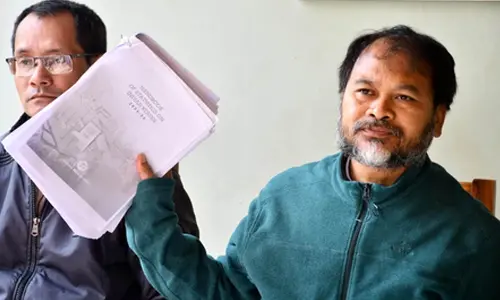Here's what young Indians really want from life…

As the fastest growing economy today, India is home to a fifth of the world's youth.
As the fastest growing economy today, India is home to a fifth of the world's youth. Half of its population of 1.3 billion is below the age of 25, and a quarter is below the age of 14.
India's young population is its most valuable asset and most pressing challenge. It provides India with a unique demographic advantage.
But this opportunity will be lost without proportionate investment in human capital development. At the same time, the world today is more dynamic and uncertain than ever before.
As India undergoes rapid and concurrent economic, demographic, social and technological shifts, it must ensure that its growth is inclusive and is shared by all sections of the society.
India will not be able to realize its true growth potential its youth is not able to participate adequately and productively in its economy.
In order to understand which skills and jobs India's young people want and assess whether the current education system meets these aspirations, the World Economic Forum and the Observer Research Foundation collaboratively conducted a survey of more than 5,000 youth in India.
The results indicate that young Indians are ambitious and show greater autonomy in their career decisions. They acknowledge changing skill requirements and are eager to pursue higher education, undergo additional training and enrol in skill development programmes.
At the same time, various factors are blocking their ambitions and preventing them from adapting effectively to the changing nature of work.
The survey's insights can inform policies and strategic action to ensure that India's young people transition smoothly from from education to economic activity. Here are some key findings:
Indian youth are independent, optimistic and open to a changing labour market
The influence of family and peers on the career and educational choices of India's youth is in decline. Young people are increasingly seeking productive employment opportunities and career paths that reflect their individual aspirations.
Around half of the respondents cite interest in their field of study as the primary reason for their choice, while 19 per cent report being influenced by their families.
Moreover, a third of the respondents report being interested in entrepreneurship, and 63 per cent report being highly or moderately interested in supplementing their income with gig work.
This shows a degree of openness towards alternative forms of employment.
Indian youth need more guidance and career counselling
Many youth report to facing multiple barriers to finding desirable and suitable job opportunities.
Factors like information asymmetries on jobs and skills, and lack of guidance for setting realistic career goals and making professional choices, are holding back young Indians.
51 per cent of respondents report that a lack of information about available job opportunities that match their skill sets is a significant barrier.
Around 30 per cent report a lack of access to any kind of counselling or mentoring opportunities. 44 per cent of respondents view this as the most important factor in the demand-supply mismatch.
Greater access to career counselling and mentoring services can help to address these misalignments between skills and aspirations, and improve young Indians' career choices.
Young Indians are interested in pursuing higher education and skills development
84 per cent of respondents consider a post-graduate degree as a requirement for their ideal job, while 97 per cent aspire to a degree in higher education.
They are also keen on other forms of ongoing education, with 76 per cent of youth reporting that they are very interested in participating in a skills development programme.
Increased employment opportunities and higher wages are the main motivators for this goal.
This contrasts with the fact that less than 3 per cent of the country's total working population is vocationally or professionally trained, compared to between 60-70 per cent among developed countries.
India must leverage the optimism of its youth and support the proliferation of high-quality education and training opportunities.
At present, there is an acute lack of awareness of available government-run skill development programmes. There is also significant scepticism about their quality and relevance.
In order to enhance the uptake of existing programmes, it is critical to make them relevant, affordable and accessible.
The private sector must do more to bridge the skills gap
The private sector needs to play a more active role in enhancing the capabilities and skills of India's youth.
India is faced with a paradox: there is significant youth unemployment, and yet the private sector bemoans a lack of adequately skilled and market-ready workers. Notwithstanding the government's role in providing basic education and training, there is a significant need for greater private sector involvement.
This will ensure that training initiatives are demand-driven and impart skills that match industry requirements.
These programmes can be supplemented with career guidance activities with industry professionals, such as talks, seminars and workplace visits.
India's socio-cultural norms add further complexity
34 per cent of the surveyed youth report that discriminatory and personal biases related to their marital status, gender, age or family background are a major barrier when looking for a job.
82 per cent of female respondents said their ideal employment would be full-time, disproving the stereotype that women prefer part-time jobs.
Similarly, despite the persistent view that household work and unpaid work are suitable and desirable for women, only 1 per cent of surveyed female youth report this as being a desirable option for them.
As the nature of work changes with the Fourth Industrial Revolution, existing gender-based biases are likely to widen if dedicated policies and initiatives are not implemented to address them.
Efforts are needed to reduce rather than replicate the biases of today in the future workspace.
Social Media and the internet can play a bigger role in effective job-hunting
81 per cent of survey respondents rely on media and internet sources for obtaining information about employment opportunities.
This is particularly insightful in light of the finding from the Future of Work, Education and Skills Survey which reveals that just 14 per centt of surveyed firms reported using online recruitment channels.
The prevalence of social media and internet use among India's youth presents an opportunity to expand their awareness about education pathways, employment opportunities, skill needs, and available skill development programmes.
For 63 per cent of the respondents, a good salary is the most important criteria for choosing a job.
The perception of higher pay and job security is consequential in a majority of Indian youth preferring to work in the public sector and exhibiting scepticism for unconventional employment options like gig work and self-employment.
More information on the changing labour market and emerging job roles through internet can help break these stereotypes and boost Indians' appetite for diverse professional and educational pursuits.
There are steps in the right direction, such as the Indian government's Start Up India initiative to boost entrepreneurship; the launch of the Skill India mission; the establishment of a dedicated Ministry of Skill Development and Entrepreneurship; the establishment of industry-led sector skills councils, and the overhaul of the Industrial Training Institutes.
Source: www.weforum.org
India set to become the world's youngest country by 2020
By 2020, the average age in India will be 29 and it is set to become the world's youngest country with 64% of its population falling under the working age bracket.
This demographic potential offers India and its growing economy an unprecedented edge that economists believe could add a significant 2% to the GDP growth rate.
However, countries like the US, South Korea, Japan, China and those in Western Europe have grown rich before growing old. They invested in education and skills, health, empowerment and employment and ensured women joined the workforce, as they were empowered to plan their families.
India is currently enjoying a 'demographic dividend', which means, it has a higher labour force than the population dependent on it.
While this may appear a reason for blissful complacency, it must be remembered that by the latter half of the century, India will have an increasingly aging population. And yet, the country lacks an adequate social security net for the needs of its people.
However, a demographic disaster looms too. This is caused by low levels of investment in education and health. Currently, the majority of Indian workers – nine out of ten – are in the informal sector, where employment is unsteady, pay is poor and social security is lacking.
Education, especially secondary education for girls, must be prioritised. The gross enrolment ratio for girls at the secondary school level is 80.97% (slightly higher than for boys) but the government cannot rest until that number is 100.
The 10% cut in government allocation for the school sector means the push to towards total gross enrolment just got harder.
The country must also generate large scale employment, taking care to ensure more women join the workforce. Concurrently, access to quality higher education must be expedited; currently, a large number of graduates are not considered employable.
Whether India's youth will be a blessing or a curse – a demographic dividend or a disaster – firmly rests in the hands of the government and the pro-youth policies it implements.
Source: www.youthkiawaaz.com














